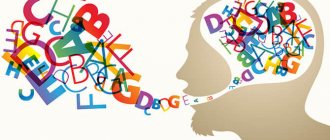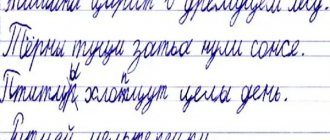Aphasia is a systemic speech disorder that occurs with organic lesions of the brain, covers different levels of speech organization, affects its connections with other mental processes and leads to disintegration of the entire mental sphere of a person.
Aphasia includes four components - a violation of speech itself and verbal communication, a violation of other mental processes associated with speech, a change in personality and personal reaction to the disease.
The causes of aphasia are cerebral circulation disorders (ischemia, hemorrhage), trauma, tumors, and infectious diseases of the brain. Aphasia of vascular origin most often occurs in adults. As a result of rupture of cerebral aneurysms, thromboembolism caused by rheumatic heart disease, and traumatic brain injuries, aphasia is often observed in adolescents and young adults.
The complexity of the speech disorder in aphasia depends on the location of the lesion. A.R. Luria distinguishes six forms of aphasia:
- acoustic-gnostic and acoustic-mnestic aphasia, which occurs when the temporal parts of the cerebral cortex are damaged,
- semantic aphasia and afferent motor aphasia, arising from damage to the lower parietal parts of the cerebral cortex,
- efferent motor aphasia and dynamic aphasia, which occur with damage to the premotor and posterior frontal parts of the cerebral cortex (on the left in right-handed people).
When speech zones are damaged, there is a violation of the so-called primary prerequisite that carries out the specific activity of the corresponding analyzer system. Based on the primary analytical disturbance, a secondary, also specific, collapse of the entire functional system of language and speech occurs, i.e. There is a violation of all types of speech activity: understanding speech, oral and written speech, counting, etc.
Peculiarities
Motor aphasia is brain damage in Broca's area, which is characterized by irreversible organic changes in brain tissue with a complete loss of its functional activity in this area. Experts distinguish two main clinically significant forms of motor aphasia: afferent and efferent motor aphasia. With this disease, there is a disruption of the synthetic activity of the brain with loss of speech function, together with its perception. In this case, the patient has no situational speech, i.e. the patient cannot maintain a dialogue because he simply does not perceive it.
Afferent motor aphasia
Afferent or kinesthetic aphasia is manifested by difficulty in reproducing speech, mainly due to problems in the articulatory apparatus. Thus, patients with afferent motor aphasia cannot and cannot connect their own speech into a complete structured sentence.
Patients often try to replace words that they cannot pronounce with synonyms, which leads to a significant slowdown in spoken speech. The difficulty in pronouncing consonant sounds also attracts attention.
In most cases, afferent motor aphasia is combined with agraphia, a writing disorder.
Efferent motor aphasia
It occurs as a result of damage to the premotor areas of the cerebral cortex. Efferent motor aphasia manifests itself by literally jamming the patient’s speech on specific sounds. The patient cannot change the position of the articulatory apparatus, which leads to large time pauses between pronounced sounds. Speech becomes telegraphic or stamped.
It is worth noting that in almost half of all cases of identified motor aphasia in patients, a combination of both afferent and efferent aphasia occurs. Mixed aphasia is manifested by a complex manifestation of all of the above manifestations, which is called the term sensorimotor speech disorder.
ACOUSTIC-GNOSTIC SENSORY APHASIA
This form of aphasia is characterized by impaired understanding of speech when perceiving it by ear. The basis of speech acoustic agnosia is a violation of phonemic hearing. Someone else's speech is perceived as an inarticulate stream of sounds. Inability to understand the speech of others and the absence of obvious motor disorders leads to the fact that patients do not always immediately realize that they have a speech disorder associated with a stroke or injury.
With sensory aphasia, the root lexical-semantic part of a word is difficult to catch by ear, resulting in a loss of its subject relevance. However, the categorical attribution of a word can be “perceived.” For example, hearing the word bell, the patient says: “It’s something small, but I don’t know what.” In patients with acoustic-gnostic sensory aphasia, auditory control of their speech is disrupted. Because of this, many literary and verbal paraphasias arise.
The patient’s early speech may be completely incomprehensible to others; it consists of random sets of sounds, syllables, and phrases, which is called “jargonophasis” or “speech hash.”
Due to a violation of phonemic perception, the repetition of words suffers a second time, and the rhythmic and melodic basis is lost. The period of jargonophasia lasts no more than 1.5 - 2 months, gradually giving way to logorrhea with pronounced agrammatism. In the study of the nominative function in sensory, acoustic-gnostic aphasia, along with correct naming, attempts are observed to explain the meaning of the word or find it through the phraseological context. For example, when naming an apple, it is said: “Well, of course, I know very well that it is a pear, not a pear, a sour apple,” etc.
When reading, many literary paraphasias appear, difficulty arises in finding the place of stress in a word, which makes reading comprehension more difficult. But reading remains the most preserved speech function in sensory aphasia.
Written speech is impaired to a greater extent and is directly dependent on the state of phonemic hearing. Severe counting disorders in sensory acoustic-gnostic aphasia are observed only at a very early stage.
Causes of afferent motor aphasia
The causes of the formation of motor afferent aphasia are a number of diseases that lead to organic damage to the cerebral cortex, including Broca’s area, as well as the premotor cortex. Most often, afferent aphasia is caused by diseases with extensive damage to brain structures, for example:
- Acute cerebrovascular accident or stroke. Moreover, a stroke is hemorrhagic in nature, in which massive hemorrhage occurs in the structures of the brain. Blood soaking and compression of the posterior regions of the frontal zone leads to damage to Broca's center and the development of afferent motor aphasia;
- Infectious and inflammatory diseases of the brain. Most often these include encephalitis or leukoencephalitis. Inflammatory diseases lead to softening of brain tissue and the formation of abscess cavities;
- Traumatic brain injuries, especially with severe brain contusion and subarachnoid hemorrhage. Brain contusion and edema lead to compression of brain structures, which can also damage Broca’s center;
- Development of a tumor process localized in the frontal or temporal lobes on the side of the dominant hemisphere;
- Epilepsy, in the presence of an epileptogenic focus in close anatomical proximity to the speech center of the brain;
- Toxic damage to brain structures, for example, from heavy metals or other poisons.
A number of chronic diseases also contribute to the development of afferent motor aphasia:
- Chronic pathology of blood circulation, due to the presence of an aneurysm or atherosclerotic changes in the vascular wall of the cerebral arteries.
- Slowly progressive diseases of the central nervous system: multiple sclerosis or encephalomyelitis. Demyelination of nerve fibers leads to disruption of afferent and efferent connections of the speech center with other structures of the brain;
- Formation of prion protein.
Symptoms
Afferent aphasia is accompanied by the occurrence of a number of symptoms and syndromes, which form the clinical picture characteristic of this form. Expressive language impairment syndrome includes:
- Violation of spatial movements, such as facial expressions and gestures, as well as a complete absence of situational speech process. When trying to repeat sounds, the patient makes only isolated movements with his lips and tongue;
- Speech becomes overly clichéd, there are syllable and sound dropouts.
The patient also experiences pronounced difficulties in pronouncing complex syllables, namely: they divide words into parts and skip the most complex sounds. There is a violation of the understanding of someone else's speech, however, this period does not last long from a day to several days and occurs after suffering an acute cerebrovascular accident.
The victim’s spatial disorientation, as well as impairment of writing and perception of visual text information, are also noteworthy. When writing, the patient shifts vowels, omits consonants, and changes the order of letters.
Diagnostics
The diagnostic search is aimed at identifying the underlying disease or cause that served as the impetus for the development of motor afferent aphasia. The diagnostic plan includes a standard set of studies. The first step is to collect an anamnesis of the disease, after which a topical diagnosis is carried out to determine the expected extent of damage to brain tissue, then a preliminary diagnosis is made.
To clarify it, a number of instrumental studies are carried out, such as:
- Magnetic resonance imaging of the brain, and contrast can also be used to improve brain imaging characteristics. Magnetic resonance imaging allows you to identify oncological lesions, the presence and volume of a hematoma in traumatic brain injury;
- Angiography of cerebral arteries for the presence or absence of vascular pathology;
- Ultrasound Doppler examination of neck vessels;
- Lumbar puncture if there is suspicion of encephalitis, meningitis or leukoencephalitis;
- Electroencephalography to exclude pathology of an epileptiform nature or oncological lesions of the brain.
The Clinical Brain Institute is focused on studying, diagnosing and treating patients with neurological symptoms, including patients with motor aphasia. The Clinical Institute of the Brain operates a powerful and modern diagnostic department, which makes it possible to make correct diagnoses with a high degree of probability.
Communication Guide
You can and should communicate with people with aphasia. Patients retain some communicative abilities that need to be activated through communication, without allowing them to “fade away.” Those who suffer from a severe form of aphasia retain the ability to understand the meaning of what is said (although not every word individually). Often the patient may not understand what is being said to him because he does not remember the meaning of individual words or forgets the beginning of a phrase.
How to communicate with people with aphasia:
- sit down and catch the person's eye
- if you are afraid of communication, you should start with simple topics, for example, tell how your day was in the simplest terms, then you need to ask a simple question
- It’s better to speak at a slow pace, focusing your voice on key words in the text
- You can do the following practice: write down the key words of the future conversation on paper, then repeat what was said and show the paper to the patient. This will be his cue for conversation.
- use not only the spoken word to communicate, but also writing, drawings, gestures, and pointing at objects. Forgive a person to do the same, let him use a dictionary if it will be easier to communicate
- if the patient is trying to convey some idea to you, determine who he is talking about, what exactly happened and in what place
- it is important to be able to ask leading questions
- do not ask questions that require monosyllabic answers
- be patient, because communication with a person with aphasia is far from easy, but it is necessary
Treatment
The main treatment should be aimed at eliminating the underlying cause that led to the formation of afferent motor aphasia. Depending on the underlying pathology, treatment tactics will differ significantly.
- In the presence of a tumor process, surgical intervention on the brain or a course of radiation and chemotherapy.
- In the presence of an infectious focus or abscess, drainage in combination with antibacterial therapy and the use of general stabilizing drugs.
- In case of acute cerebrovascular accident - a course of treatment with drugs with nootropic effects, antioxidants, angioprotectors. For hemorrhagic stroke with severe compression of the brain - surgical treatment.
- For epilepsy, the main therapy is aimed at the use of anticonvulsants.
- For demyelinating and degenerative processes in nervous tissue, glucocorticosteroids are used.
All of the above treatment regimens will be effective in the treatment of aphasia, as they have a pathogenetic mechanism for correcting the pathological manifestations of the disease.
Rehabilitation
It is very important that the treatment is comprehensive and closely related to rehabilitation measures. The Clinical Institute of the Brain is one of the first centers in the country that began the combined use of therapeutic and rehabilitation measures. Rehabilitation consists of:
- Systematic visits to a speech therapist, at least three times a week;
- Dual mode operation, i.e. both with a specialist and independently.
Rehabilitation classes are aimed at restoring articulate speech; for this, patients sing songs and read poetry, since during these classes words are stretched into syllables and train the patient’s articulatory apparatus. Separately, it is worth mentioning the restoration of writing; for this, patients write letters under dictation.
For a more effective and quick recovery of the patient, it is necessary to involve close relatives and friends in treatment. The patient should not be allowed to remain and be in social isolation for a long time.
At the Clinical Institute of the Brain, there is a specialist aphysiologist who develops individual programs for each individual patient to restore speech and writing function in cases of severe cognitive disorders.
Adviсe
Aphasia is not a mental illness, even if there are severe speech impairments. It is worth treating the patient with understanding and patience. You should not raise your voice at the patient, as this will not improve the understanding of the information and the meaning of what is being said. You should speak to the patient as slowly as possible, without using complex structures in sentences. Gestures should also be limited. Use questions that can be answered with a clear yes or no.
To improve the perception of information by patients, try to exclude all extraneous noise. Try not to limit the patient’s communication and ask him more questions.
ACOUSTIC-MNESTIC APHASIA
Acoustic-mnestic aphasia occurs when the middle and posterior parts of the temporal region are damaged. It is believed that it is based on a decrease in auditory-verbal memory, which is caused by increased inhibition of auditory traces. Acoustic-mnestic aphasia is characterized by a dissociation between the relatively intact ability to repeat individual words and the impaired ability to repeat three or four unrelated words (for example: hand-house-sky, etc.)
In acoustic-mnestic aphasia, speech memory impairment is the main defect, because phonemic hearing and the articulatory side of speech are preserved. Increased speech activity compensates for communication difficulties. The auditory verbal memory of these patients is characterized by great inertia.
Violation of the volume of retention of speech information, its inhibition leads to difficulties in understanding in this form of aphasia long, polysyllabic statements consisting of five to seven words. Patients find it difficult to navigate a conversation with two or three interlocutors, “switch off” in a difficult speech situation, cannot attend reports, lectures, and get tired when listening to music and radio broadcasts. This fact should be taken into account when prescribing such treatment methods as “art therapy”, etc.
With optical aphasia, the second variant of acoustic-mnestic aphasia, difficulties arise in retaining the semantic aspect of speech by ear; they consist in weakening and impoverishment of visual representations of an object, in the relationship between what is perceived by ear and its visual representation. The visual representation of an object becomes incomplete; those elements of objects that, on the one hand, are specific to them, and on the other hand, are associated with the polysemy of the word (for example, the words spout, comb, pen) are not completed.
Patients understand the meaning of individual words. They do not have articulatory difficulties, they are not only verbose, but also hyperactive. However, with all this, they only partially understand speech due to the narrowing of auditory-verbal memory to 1-2 out of 3 words perceived by ear. Speech is abundant, little informative, replete with verbal paraphasias, but intonation-colored.
In written speech with acoustic-mnestic aphasia, the phenomena of expressive agrammatism appear more prominently, i.e. displacement of prepositions, as well as inflections of verbs, nouns and pronouns, mainly in gender and number. The nominative side of written speech turns out to be more preserved. When recording text from dictation, patients experience significant difficulties in retaining even a phrase in their auditory-verbal memory. Consisting of three words, they are asked to repeat each fragment of the phrase.
With acoustic-mnestic aphasia, it is difficult to perceive printed text when reading. This is due to impaired preservation of auditory-verbal memory.
Prevention of afferent and efferent motor aphasia
There is no specific prevention for the development of aphasia. All preventive measures are primarily aimed at eliminating risk factors that increase the risk of vascular diseases. Since acute cerebrovascular accident is the most common cause of aphasia, stroke prevention has an indirect effect on the development of aphasia.
Timely treatment of arterial hypertension, correction of the blood lipid profile, as well as annual preventive examinations will help to avoid extensive brain damage.
As with any other disease, prevention implies:
- Maintaining a healthy lifestyle;
- Proper nutrition;
- Normalization of the work-rest regime;
- Rejection of bad habits.
Read also
Chiari malformation
What is Chiari Malformation?
Chiari malformation (formerly Arnold-Chiari malformation) is a congenital defect of brain development that involves the dislocation of the cerebellar tonsils into the spinal canal through a large... Read more
Herpes zoster
Varicella zoster first enters the human body at an early age and manifests itself as chickenpox, most often in children. Then follows the latent phase of circulation of the pathogen in the body and under certain conditions...
More details
Clubfoot
Clubfoot should not be understood as just one foot disorder. This is a group of deformities of the foot and ankle joint with their pathological setting. Clubfoot is a deformity in which...
More details
Amyotrophy
The word atrophy, translated from Latin, means loss or decrease in the volume of muscle mass or an individual muscle. Most often, muscle atrophy occurs due to limitation of active movements, for example, after...
More details
Senestopathies
Senestopathies are various painful sensations that are almost always difficult to describe by patients, originating from various areas of the body, internal organs, and which cannot be explained...
More details






